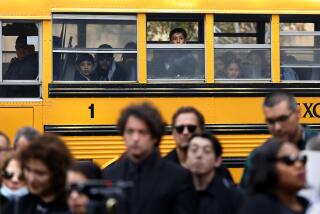By age 6, girls are less likely than boys to think that they can be brilliant, study shows

- Share via
Why do so few women end up in physics, mathematics and other fields traditionally associated with “brilliance”? Part of the answer may lie in what happens to girls by the time they’re out of kindergarten.
A new study finds that 6-year-old girls are less likely than boys to think members of their own gender can be brilliant — and they’re more likely than boys to shy away from activities requiring that exceptional intelligence. That’s a serious change from their attitudes at age 5, when they’re just as likely as boys to think their own gender can be brilliant, and just as willing to take on those activities for brilliant children.
The results, described in the journal Science, shows how early these gender stereotypes begin to affect the self-perception and behavior of girls — which may limit their aspirations and careers into adulthood.
“If we want to change young people’s minds and make things more equitable for girls, we really need to know when this problematic stereotype first emerges, and then we know when to intervene to avoid these negative consequences on girls’ educational decisions and their future career choices,” said lead author Lin Bian, a graduate student in psychology at the University of Illinois at Urbana-Champaign.
The stereotype that men are better at math and science is a pervasive one, difficult to dislodge even at the highest echelons of higher education. In 2005, Harvard President Lawrence Summers stirred up controversy during a speech in which he said that women were underrepresented in the sciences in part because of “issues of intrinsic aptitude.”
And a study in the journal PLOS One last year found that men in college-level biology classes consistently overestimated the performance of their male peers and underestimated the performance of their female classmates. (The women, by the way, evaluated their fellow students far more accurately in terms of performance, apparently without regard to gender.)
These ideas aren’t just a reflection of perceived differences in gender, according to Bian and her colleagues. They’re also a reflection of perceived intelligence.
“Popular beliefs about ability associate not only specific cognitive processes (e.g., mathematical reasoning) with a particular gender but also the overall amount of cognitive ability,” the study authors wrote. “It is commonly assumed that high-level cognitive ability (brilliance, genius, giftedness, etc.) is present more often in men than in women. This ‘brilliance = males’ stereotype has been invoked to explain the gender gaps in many prestigious occupations.”
These stereotypes may have serious consequences for young women in college and their future careers. For example, the authors point out, previous research has shown that the idea that men are better than women at math actually impairs women’s performance and undermines their interest in math-related fields.
But how far back does the stereotype that men are more likely to be “brilliant” start to shape the behaviors of young men and women? To find out, the scientists set up a series of experiments to test the gender perceptions of 5-, 6- and 7-year-olds.
In one experiment, 96 children were told a story about a person who was “really, really smart” – a kid-friendly version of the word “brilliant” – but they weren’t told the person’s gender. The children were then asked to guess which of four adults, two men and two women, that person was. They were also shown pairs of adults – both women, both men, or a man and a woman – and asked to pick which adult in each pair was “really, really smart.” Finally, they completed puzzles in which they had to associate objects (such as a hammer) or attributes (including “smart”) with pictures of men and women.
The scientists found that between ages 5 and 7, children’s perceptions of brilliance go through fairly dramatic changes. At 5, boys and girls both associated brilliance with their own gender on roughly the same level. But by 6 and 7, girls were significantly less likely than boys to associate brilliance with their own gender.
The second experiment replicated the first one — except with 144 children who were asked to also rate kids, not just adults, in the tasks — and the results still held.
Strangely, when asked who got the best grades in school, the older girls were just as likely as the younger ones to pick girls — and in fact, older girls were more likely than older boys to choose their own gender as getting the best grades.
This was consistent with the reality that girls do get better grades than boys at that age, the authors wrote.
“Nevertheless, there was no significant correlation between girls’ perceptions of school achievement and their perceptions of brilliance,” the authors wrote. “Thus, girls’ ideas about who is brilliant are not rooted in their perceptions of who performs well in school.”
The authors also tested whether these beliefs about gender and brilliance affected girls’ interests. The researchers had 64 6- and 7-year-olds play two games — one for “really, really smart” (i.e. “brilliant”) children and one for “children who try really, really hard.” Girls seemed drawn to the “hard-working” game about as much as boys — but they were significantly less interested than boys were in the game for brilliant kids.
When the researchers repeated the study with 96 5- and 6-year-olds, however, they found no significant differences in the 5-year-old girls’ and boys’ interest. (The 6-year-old girls, on the other hand, clearly had begun to lose their enthusiasm for the “smart” games.)
“The present results suggest a sobering conclusion: Many children assimilate the idea that brilliance is a male quality at a young age,” the authors wrote. “This stereotype begins to shape children’s interests as soon as it is acquired and is thus likely to narrow the range of careers they will one day contemplate.”
That this shift occurs around age 5 may have to do with children entering more formal school scenarios, where they’re exposed to many other people (both children and adults), said Yarrow Dunham, a developmental psychologist at Yale University who was not involved in the study.
It’s unclear which of the myriad social influences happening at the time could be contributing to girls’ shift in self-perception, he added. It’s possible, for example, that teachers might be unconsciously reinforcing stereotypes by how they respond to boys and girls in the classroom. Or perhaps the exposure to history books that mostly feature men causes children to assume that women are largely absent because they were less intelligent (rather than because of laws and social mores that for centuries treated women as second-class citizens). For now, the complex causes of these stereotypes remain an open question.
“It is disheartening and it really calls for some thought about identifying what are the causal variables,” Dunham said. “Is it teachers? Is it the kind of historical materials that they’re exposed to? Because some of those will be easier fixes than others. And so identifying which is the main causal variable seems pretty important.”
Identifying those variables will be the first step to figuring out how to weed out these stereotypes as soon as they take root.
Follow @aminawrite on Twitter for more science news and “like” Los Angeles Times Science & Health on Facebook.
MORE IN SCIENCE
Here’s what primary care doctors really think about Obamacare
It’s possible to ‘vaccinate’ Americans against fake news, experiment shows
Trump administration moves make scientists nervous. Here’s what they’re planning to do about it
UPDATES:
6:20 p.m.: This story was updated with comment from Yarrow Dunham and additional context.
This article was originally published at 11:50 a.m.






